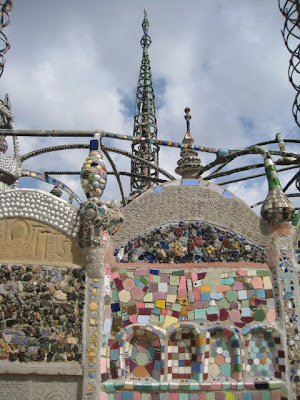
Sunday, January 16th, we went to Suprasensorial: Experiments in Light, Color, and Space at the Geffen Contemporary at MOCA. When I found this exhibition at MOCA I was so excited to bring my one-year-old through it. She really got into Between Bodies/Tijuana by Nina Waisman, an audio installation at the 2010 California Biennial at the Orange County Museum of Art we experienced a few months ago. And she just started swimming lessons at the YMCA two Saturdays ago, so I thought Hélio Oiticica and Neville D'Almeida's Cosmococa-Programa in Progress, CC4 Nocagions (the one with the pool) would just be the coolest thing ever.
MOCA's website seemed to emphasize the logistics of using the pool so it seemed like they really wanted people to swim to complete the piece. I searched everywhere for a report of someone's actual experience swimming in the pool as part of this exhibit. I found nothing. I just trusted that when they said they'd have towels and
changing rooms they'd really have towels and changing rooms. I figured as long as I packed our swimsuits, it would be totally doable.
After experiencing all the other pieces, we finally arrived at the staging area for piece and it looked promising. They had a lovely stack of clean towels and dressing stalls as private as any clothing store. There were other families in the pool. A lifeguard was on duty. We had our suits. No problem.
So we changed into our swimsuits and went into the installation. There were little cushions on the deck along the edge of the pool to sit on. So I sat on one of the cushions with my child in my arms with the idea that I'd scope out the pool and then get in. Well, the cushion sort of slipped so I slid into the pool, landed on my feet just fine, with my child in my arms. A little more of a surprise entry than I had hoped for, but no big deal.

The water was as warm as the Y's heated pool. It was really shallow (90 centimeters as described in the information about the piece I'd read beforehand). The floor and sides of the pool are a slippery plastic that reminded me of the bottoms of above ground pools when I was a kid. But with a little care, I managed not to slip in such a way that might imperil my child.
We did our front glides and our back float just like in swim class, but in a dark room in a pool with blue lights around it while slides of John Cage's musical scores covered in cocaine cycled on the wall all to the music of John Cage. Sounds weird, but my child totally dug it. She was actually way more into it than she was into swim class the day before. The lifeguard was really friendly and complimented us for coordinating our blue and green swimsuits with the blue and green lights in the
installation, which was somewhat intentional on my part. I felt like I had done this literal immersion of my child in art really well.

Then it was time to get out of the pool. My child was easy. Her dad had a towel and I handed her up to him. No problem. Also, no ladder. No stairs. No grab rails. No nothing to help you get out of that pool. But it's only 90 centimeters deep, right? Well, the water is only 90 centimeters deep, but the side of the pool actually extends about another foot and a half. So that's about four and a half feet. I'm 5'7". Now, I've jumped out of the side of a pool before, but it's
actually easier if the pool is a little deeper because you've got buoyancy on your side, and I am nothing if not buoyant. But in only three feet of water, you get no help from buoyancy. The height of the pool was too high for me to get my arms under me sufficiently to pull myself out. I will also concede that my upper body strength is nonexistent.
So I jumped off the slippery bottom of the pool and pushed myself up with my arms as far as I could go. I leaned over onto the deck as much as I could. The edge of the pool was hard, sharp, and non-slip, so it was pretty tough to shimmy up even when I got my upper body onto the deck. Then I tried to throw my leg up onto the deck. I gave it my best shot about four times before the lifeguard hoisted me from the top and some totally random and quite probably very sketchy dude pushed me from the back and very slowly extricated me from the pool.
In addition to the glaring, but rather temporary humiliation (which I'm furthering by retelling this story as often as possible), I suffered some SERIOUS bruises on my tummy and leg.
The moral of the story: when you immerse yourself in art, you need an exit strategy.
If you're in the L.A. area before the show closes February 27th, my daughter and I highly recommend you go. Next Suprasensorial will travel to the Hirshhorn Museum and Sculpture Garden in Washington D.C., where it will be on view from June 23 through September 11, 2011. Be sure to pack a swimsuit and work out an exit strategy.









